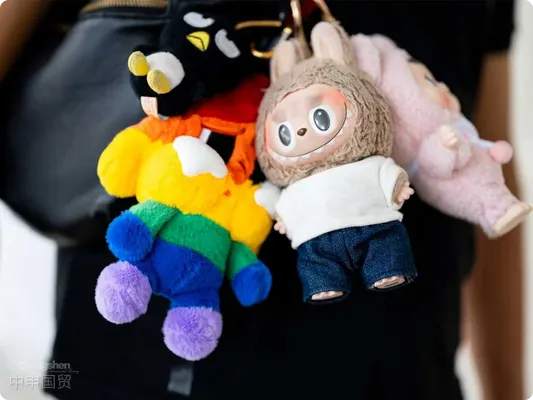- Shanghai Zhongshen International Trade Co., Ltd. - Two decades of trade agency expertise.
- Service Hotline: 139 1787 2118
Japanese media recently reported that Thai consumers are enthusiastic about purchasing Chinese figurines, drawing attention to the popularity of Chinas toy industry in Southeast Asia. Thirty years ago, Chinese toy companies began shifting production capacity globally, but early efforts were more OEM-based with low added value. Today, as quality and design levels continue to improve, Chinas toy industry is gradually shaping a new international image. For the Southeast Asian market, China is no longer just a labor-intensive OEM factory but is moving toward the mid-to-high end of the global value chain with higher quality and more creative Toy Manufacturing 2.0 models.
Taking the Chinese trendy toy Labubu as an example, this pointy-eared plush toy, launched by Pop Mart, became a fashion trend among young Chinese consumers and quickly gained popularity in Thailand, Vietnam, and other Southeast Asian countries. Over the past few months, Labubu has been seen everywhere at Bangkok airports and Vietnamese e-commerce platforms. Celebrity endorsements and social media viral marketing have spurred a buying frenzy for this Chinese trendy toy in Southeast Asia. A photo of Thai Princess Sirivannavari wearing a Labubu accessory at an event became a catalyst for the toys sudden popularity. Southeast Asian consumers share similar cultural preferences and aesthetic trends with China, and economic development and rising social media penetration have provided fertile ground for the accelerated overseas expansion of Chinese trendy toys.

The breakthrough of Chinas toy industry in overseas markets is not only due to social media and celebrity effects but also stems from the deep upgrades in domestic supply chains and independent innovation capabilities over the past few years. From traditional OEM factories to brand builders driven by independent design, Chinese toy manufacturers have continuously improved in technology, quality, and creativity. China is the worlds largest toy producer, and industrial clusters in Chenghai, Dongguan, Shenzhen, and other regions provide companies with comprehensive upstream and downstream support and flexible supply chains. Companies can obtain required components and supporting services in a very short time. The完善 of industrial配套 helps reduce costs and accelerate product iteration, allowing brand owners to focus more on creative design and intellectual property.
According to industry observers, in the past,歐美 markets were the main destinations for Chinese toy exports. However, Southeast Asia has recently become a fast-growing emerging market. Chinese customs data shows that the U.S. remains the largest export market for Chinese toys in the first half of this year, but exports to ASEAN have also grown steadily during the same period. The market potential of Singapore, Cambodia, Thailand, and other countries is being釋放. German data統(tǒng)計 company Statista predicts that the Southeast Asian toy market will be worth approximately $5.64 billion in 2023 and grow to $6.52 billion by 2028. Against this backdrop,越來越多的 Chinese toy companies are viewing Southeast Asia as a strategic stronghold,搶占 market share with innovative designs, high-quality standards, and localized marketing.
For Chinese companies, the Southeast Asian market not only means expanding sales channels but also provides opportunities for碰撞 of diverse cultures and styles. Some Chinese brands本地化 their product designs, such as incorporating Southeast Asian traditional patterns or clothing elements into trendy toys, to贏得 local consumers認(rèn)同感. Behind this innovative strategy is the high importance Chinese toy companies place on intellectual property protection and brand building. Over the past 30 years, Chinas toy industry once faced代工 patterns and counterfeit issues, but now it is built on合法授權(quán), brand output, and intellectual property protection, showcasing鮮明的 brand awareness and cultural confidence.
From代工 at the end of the supply chain to自主 IP孵化, the role of Chinese toy companies in the global market is quietly transforming. The traditional 貼牌生產(chǎn) model can no longer meet the個性化 and品質(zhì)化 demands of the new generation of consumers. Chinese companies are winning the favor of international markets with自主 design, rapid market response, and creative cultural輸出. In high-end toy markets in Europe and the Americas, over 80% of products are still made in China. In Southeast Asia and around the world, with the布局 of海外倉, expansion of e-commerce platforms, and加持 of social media marketing, Chinese toy brands are gradually shedding their low-end代工 image.
Looking ahead, Chinese toy companies need to continue發(fā)力 in the process of brand國際化. In addition to maintaining competitiveness in quality and design, they must actively participate in international exhibitions and marketing activities, collaborate with local distributors and artists, and create跨 cultural products that combine本地 elements with international視野. Associations and institutions are also providing resources and platforms to help Chinese brands establish more穩(wěn)固 market roots overseas.
Thirty years of change mean that Chinas toy出海 model has already改頭換面. Trendy toys, IP授權(quán), cultural融合, and數(shù)字化 channel expansion... these elements together constitute the出海密碼 of Chinas toy industry in the new era. The Chinese figurines and trendy toys流行 in Southeast Asia are the best注腳 of Chinas玩具全面升級 and華麗轉(zhuǎn)身.
Related Recommendations
? 2025. All Rights Reserved. 滬ICP備2023007705號-2  PSB Record: Shanghai No.31011502009912
PSB Record: Shanghai No.31011502009912









